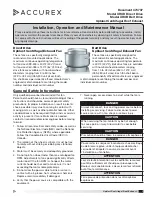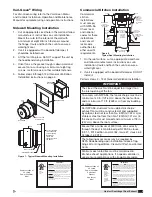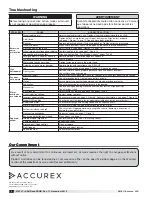
Upblast Centrifugal Roof Exhaust
3
When lifting a Belt Drive unit onto the roof, use either
the four lifting points on the drive frame or the two lifting
points on the bearing plate if present, see Figure 2 for
lifting points. Access to the drive frame is accomplished
by removing the screws pointed out in Figure 3
.
The
cover can then be removed and placed on a flat surface
in an area protected from strong winds.
When the Direct and/or Belt Drive unit is on the roof,
move fan to desired location using lifting points and
fasten securely through mounting holes in base. Shims
may be necessary depending upon roofing material
thickness.
The motor amperage and voltage ratings must be
checked for compatibility to supply voltage prior to
final electrical connection. For Direct and/or Belt Drive
installations, the electrical supply should be routed
through the conduit chase located between the curb
cap and the bottom of the motor compartment or
through the breather tube. Wiring must conform to local
and national codes.
Storage
Fans are protected against damage during shipment.
If the unit cannot be installed and operated immediately,
precautions need to be taken to prevent deterioration of
the unit during storage. The user assumes responsibility
of the fan and accessories while in storage. The
manufacturer will not be responsible for damage
during storage. These suggestions are provided solely
as a convenience to the user.
Indoor
The ideal environment for the storage of fans and
accessories is indoors, above grade, in a low humidity
atmosphere which is sealed to prevent the entry of
blowing dust, rain or snow. Temperatures should be
evenly maintained between 30° to 110°F
(-1° to 43°C)
(wide temperature swings may cause condensation
and “sweating” of metal parts). All accessories must be
stored indoors in a clean, dry atmosphere. Remove any
accumulations of dirt, water, ice or snow and wipe dry
before moving to indoor storage. To avoid “sweating” of
metal parts, allow cold parts to reach room temperature.
To dry parts and packages, use a portable electric
heater to get rid of any moisture buildup. Leave
coverings loose to permit air circulation and to allow for
periodic inspection.
The unit should be stored at least 3½ inches
(89 mm)
off the floor on wooden blocks covered with moisture
proof paper or polyethylene sheathing. Aisles between
parts and along all walls should be provided to permit
air circulation and space for inspection.
IMPORTANT
Installation, troubleshooting and parts replacement
are to be performed only by qualified personnel.
Consult and follow all applicable national, state and
local codes. They will supercede this document.
Outdoor
Fans designed for outdoor applications may be stored
outdoors, if absolutely necessary. Roads or aisles for
portable cranes and hauling equipment are needed.
The fan should be placed on a level surface to prevent
water from leaking into the fan. The fan should be
elevated on an adequate number of wooden blocks so
that it is above water and snow levels and has enough
blocking to prevent it from settling into soft ground.
Locate parts far enough apart to permit air circulation,
sunlight and space for periodic inspection. To minimize
water accumulation, place all fan parts on blocking
supports so that rain water will run off.
Do not cover parts with plastic film or tarps as these
cause condensation of moisture from the air passing
through heating and cooling cycles.
Fan wheels should be blocked to prevent spinning
caused by strong winds.
Inspection and Maintenance
During Storage
While in storage, inspect fans once per month. Keep a
record of inspection and maintenance performed.
If moisture or dirt accumulations are found on parts,
the source should be located and eliminated. At each
inspection, rotate the wheel by hand ten to fifteen
revolutions to distribute lubricant in motor. If paint
deterioration begins, consideration should be given to
touch-up or repainting. Fans with special coatings may
require special techniques for touch-up or repair.
Machined parts coated with rust preventive should be
restored to good condition promptly if signs of rust
occur. Immediately remove the original rust preventive
coating with petroleum solvent and clean with lint-free
cloths. Polish any remaining rust from surface with
crocus cloth or fine emery paper and oil. Do not destroy
the continuity of the surfaces. Thoroughly wipe clean
with Tectyl
®
506 (Ashland Inc.) or the equivalent. For
hard to reach internal surfaces or for occasional use,
consider using Tectyl
®
511M Rust Preventive, WD-40
®
or the equivalent.
Removing From Storage
As fans are removed from storage to be installed in
their final location, they should be protected and
maintained in a similar fashion until the fan equipment
goes into operation.






























